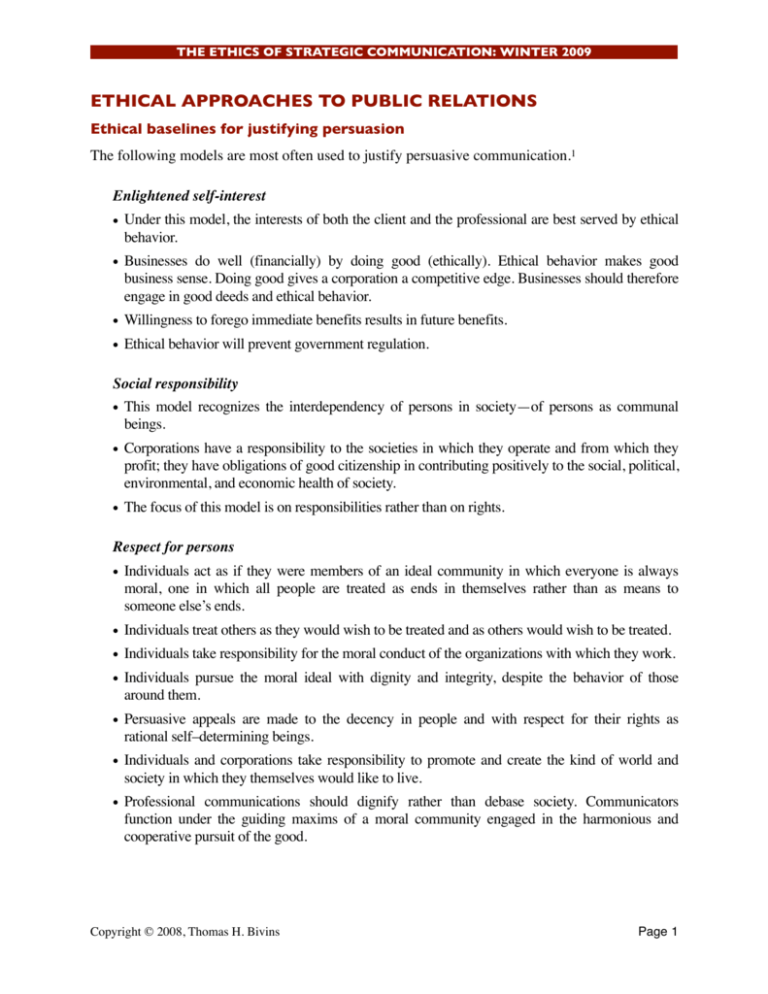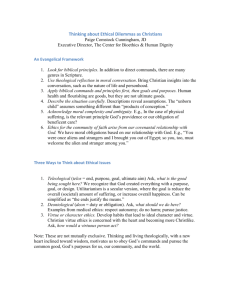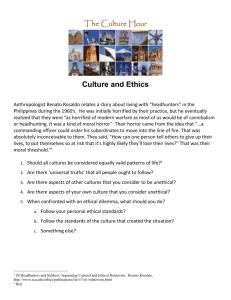ethical approaches to public relations
advertisement

THE ETHICS OF STRATEGIC COMMUNICATION: WINTER 2009 ETHICAL APPROACHES TO PUBLIC RELATIONS Ethical baselines for justifying persuasion The following models are most often used to justify persuasive communication.1 Enlightened self-interest • Under this model, the interests of both the client and the professional are best served by ethical behavior. • Businesses do well (financially) by doing good (ethically). Ethical behavior makes good business sense. Doing good gives a corporation a competitive edge. Businesses should therefore engage in good deeds and ethical behavior. • Willingness to forego immediate benefits results in future benefits. • Ethical behavior will prevent government regulation. Social responsibility • This model recognizes the interdependency of persons in society—of persons as communal beings. • Corporations have a responsibility to the societies in which they operate and from which they profit; they have obligations of good citizenship in contributing positively to the social, political, environmental, and economic health of society. • The focus of this model is on responsibilities rather than on rights. Respect for persons • Individuals act as if they were members of an ideal community in which everyone is always moral, one in which all people are treated as ends in themselves rather than as means to someone else’s ends. • Individuals treat others as they would wish to be treated and as others would wish to be treated. • Individuals take responsibility for the moral conduct of the organizations with which they work. • Individuals pursue the moral ideal with dignity and integrity, despite the behavior of those around them. • Persuasive appeals are made to the decency in people and with respect for their rights as rational self–determining beings. • Individuals and corporations take responsibility to promote and create the kind of world and society in which they themselves would like to live. • Professional communications should dignify rather than debase society. Communicators function under the guiding maxims of a moral community engaged in the harmonious and cooperative pursuit of the good. Copyright © 2008, Thomas H. Bivins Page 1 THE ETHICS OF STRATEGIC COMMUNICATION: WINTER 2009 Responsible Advocacy This approach to public relations proposes that the best way to practice public relations ethics is through the ideal of professional responsibility.2 The contention here is that these imperatives can work together if we consider the public relations practitioner as a professional. The key points of this approach are: • Public relations practitioners’ greatest need for ethical guidance is in the reconciling of their conflicting roles of professional advocate and organizational social conscience. • Public relations professionals best serve society by serving the special interests of clients or employers. • First loyalty is always to the client, but public relations professionals also have a responsibility to voice the opinions of organizational stakeholders.3 According to the authors, three principles that could provide the foundation for a theory of professional responsibility in public relations are: 1. The comparison of harms and benefits: Harms should be avoided or, at least, minimized, and benefits promoted at the least possible cost in terms of harms. 2. Respect for Persons: Persons should be treated with respect and dignity. 3. Distributive Justice: The benefits and burdens of any action or policy should be distributed as fairly as possible. These principles are considered prima facie (accepted as correct until proved otherwise), and not absolute. They are principles that hold generally unless they conflict with one another. When only one of the principles is implicated in a moral choice, that principle should be taken as the controlling guideline for ethical conduct. However, moral dilemmas often involve conflicts between the principles. In these cases, the decision maker must employ his or her own values, moral intuition, and character to determine which principle is most important and most controlling in the particular context. The TARES Test In this elaborate test for judging the ethicality of persuasive communication, the appropriate foundation of ethical persuasion is a clearer understanding of the difference between means and ends.4 The authors of this test argue that “the end must be formulated in a way that places an emphasis on respect for those to whom particular persuasive communication efforts are directed.” They propose a five-part test of prima facie duties that they say, “defines the moral boundaries of persuasive communications and serves as a set of action-guiding principles directed toward a moral consequence in persuasion.” They are: Truthfulness of the message “The Principle of Truthfulness requires the persuader’s intention not to deceive, the intention to provide others with the truthful information they legitimately need to make good decisions about their lives.” Among the considerations are: Copyright © 2008, Thomas H. Bivins Page 2 THE ETHICS OF STRATEGIC COMMUNICATION: WINTER 2009 • The communication should be factually accurate. It should not be deceptive in any way. It should present a complete picture and avoid communicating only part of a message, especially if omissions are intended to deceive. • No false impressions should be communicated by the use of selective information. • No information should be withheld that is needed by the audience in order for them to make an informed decision, especially if the omission of this information results in harm. Authenticity of the persuader This has to do with the integrity, personal virtue, motivation, commitment to principle, and moral independence of the persuader. Among the considerations are: • The action, or communication, should conform to the highest principles and personal convictions, and should arise from noble intentions. The intent of the act should promote the well being of everyone potentially affected. This means that loyalties need to be appropriately balanced. • Persuasive communication, especially advocacy, should reflect the personal beliefs of the persuader. If you would be ashamed to be revealed as a participant in a persuasive campaign, then you shouldn’t be doing it. Respect for those being persuaded This principle requires that no one’s autonomy be violated. Your audience must be free to make their own decisions, based on truthful and complete information. Among the considerations are: • Persuasive messages should appeal to the higher natures of people, not pander, exploit, or appeal to their baser inclinations. • Messages should exhibit a sense of caring for those being communicated to. Equity of the persuasive appeal This principles requires a “parity between the persuader and persuadee in terms of information, understanding, insight, capacity, and experience, or that accommodations be made to adjust equitably for the disparities and to level the playing field.” Among the considerations are: • The persuasive act should be fairly carried out and should be just and equitable for all concerned. If there is a lack of understanding among any of your audiences, you should clarify and educate in order to reduce confusion. • Vulnerable audiences should never be targeted with messages that are designed to exploit that vulnerability. • All arguments should allow for reflection and counterargument. • It should be clear to everyone that persuasion is being attempted. Persuasive activities should never masquerade as information-only campaigns. Social responsibility This principle recognizes the professional obligation to act in the public interest and to balance loyalties among claimants. Among the considerations are: Copyright © 2008, Thomas H. Bivins Page 3 THE ETHICS OF STRATEGIC COMMUNICATION: WINTER 2009 • Any persuasive action should be responsible to society and to the public interest by working to improve life within the social realm. • Potential harms that may result from the communication should be recognized and eliminated or reduced. • Understanding should be promoted among all publics involved in the issue. A duty-based approach This approach to public relations ethics, specifically within organizations, is based solidly on the notion of autonomy and respect for persons. 5 The model proceeds through several phases. • Phase 1 is issue identification in which the PR practitioner must determine the importance of the issue. Typically, only complex issues move through the succeeding phases. Smaller issues are usually handled immediately, but can benefit from the complete process. • Phase 2 involves issues managers meeting in teams to discuss the issue, collect more information and research, or bring in experts to help analyze the issue. This is the point at which alternatives are discussed. It is also the first point at which ethical dimensions are considered. Because this theory is rules-based (deontological), it asks the decision makers to “do what is right” based on their duty to universal norms—usually concepts of fairness and rights. • Phase 3 engages the “law of autonomy,” which refers to the moral conscience of the decision makers and reminds them not to submit to undue pressure from other organizational functions. It also allows decision makers to act according to their moral duties “without fear of harmful repercussions.” Each decision maker should be allowed to express himself freely, and that expression should be respected by the others involved in the decision. This argues strongly for an autonomous public relations function within organizations. This phase also requires us to ask whether we are acting on the basis of reason alone and not because of political influence, monetary influence, or pure selfinterest. • Phase 4 asks questions such as, “Could we obligate everyone else who is ever in a similar situation to do the same thing we are considering?” or, “Would I accept this decision if I were on the receiving end?” • Phase 5 asks the organization to consider its duty, its intention, and dignity and respect for the organization, publics, and society. This would imply a willingness to be open to the input of all stakeholders, and it would validate the notion of acting out of a good will. It asks the question, “Does this decision make us worthy of earning trust, respect, and support from our publics?” “Publics and stakeholders are more likely to be satisfied with a decision when the intent of the organization toward them is based on a good will rather than when other interests taint it.” • Phase 6 calls for symmetrical communication about the results of the decision-making process. This approach works well in conjunction with phase 5 in that it allows for ongoing communication and contributions to the process by all parties. Copyright © 2008, Thomas H. Bivins Page 4 THE ETHICS OF STRATEGIC COMMUNICATION: WINTER 2009 A virtue ethics approach This approach contends that simply having a practicable ethical model, such as an ethics code, to apply to decision making won’t insure good ethical decisions. Rather, they propose that the virtue, or character, of the moral agent is more important. 6 The person of virtue values the intrinsic worth of right action (i.e., virtue is its own reward); whereas, the person who lacks virtue might feel discomfort in being forced into right action, or even see no harm in avoiding it. Achieving excellence in a practice, such as public relations, means doing something good for its own sake, and requires and develops the virtues of justice, honesty, and courage. This approach concentrates on three, primary virtues:7 Justice demands that we: • recognize the skills, knowledge, and expertise of other practitioners; and • learn from those who know more and have greater experience than we do. Courage requires that we: • take self-endangering risks; • push ourselves to the limits of our capacities; and • be prepared to challenge existing practice in the interest of extending the practice, despite institutional pressures against such critique. Honesty asks us to: • be able to accept criticism; and • learn from our errors and mistakes. In order for individual virtues to be realized, the organization in which the individual works must develop an environment conducive to the development of good character. In order to actualize these virtues, the focus of right actions should be the public interest. If this sounds a bit too idealistic, then, at the very least, “public relations practitioners may participate in and contribute to the internal good of organizations they choose to work for, as long at the organization’s focus is on doing something that is good for its own sake.” Copyright © 2008, Thomas H. Bivins Page 5 THE ETHICS OF STRATEGIC COMMUNICATION: WINTER 2009 1 Sherry Baker, “Five Baselines for Justification in Persuasion.” Journal of Mass Media Ethics, 14:2 (1999): 69-81. 2 Kathy Fitzpatrick and Candace Gauthier, “Toward a Professional Responsibility Theory of Public Relations Ethics,” Journal of Mass Media Ethics, 16:2&3 (2001): 194. 3 Amanda Holt, the PR Ethics Resource Center, http://iml.jou.ufl.edu/projects/Spring02/Holt/ 4 Sherry Baker and David L. Martinson, “The TARES Test: Five Principles for Ethical Persuasion.” Journal of Mass Media Ethics, 16:2&3) (2001): 148-175 5 Shannon A. Bowen, “Expansion of Ethics as the Tenth Generic Principle of Public Relations Excellence: A Kantian Theory and Model for Managing Ethical Issues,” Journal of Mass Media Ethics, 16:1, (2004): 65-92. 6 Karey Harrison and Chris Galloway, “Public relations ethics: A simpler (but not simplistic) approach to the complexities.” The Public Relations Resource Center, http://praxis.massey.ac.nz/fileadmin/Praxis/Files/Journal_Files/Issue3/ Harrison_Galloway.pdf 7 Alisdair MacIntyre, After virtue (2nd ed.). (Notre Dame, Indiana: University of Notre Dame Press, 1984). Cited in Harrison and Galloway, 8. Copyright © 2008, Thomas H. Bivins Page 6






